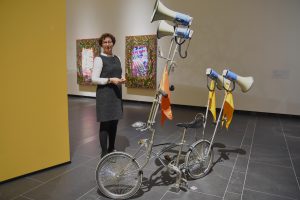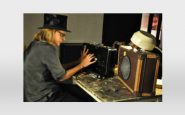« Indietro
L'intervista di questa settimana è rivolta a Päivi Viherkoski, Director of development of services, communication and tourism al Museo Serlachius di Mänttä, nella Finlandia centrale. L'intervista è condotta in lingua inglese.
Serlachius is one of the most important art museums in Scandinavia and Finland, whose activity has been relaunched with the new Gösta pavilion in 2014 by Barcellona based architect studio MX_SI. Can you explain to the Italian audience what is the mission of the museum and what kind of activities do you usually perform?
We have two Serlachius Museums, Gustaf and Gösta, which offer unique experiences of art, architecture and industrial history. We are known in Finland for the innovative exhibitions and excellent service, for example interactive drama tours, culinary pleasures and soft activities in the forest. Due to our remote location, our mission is a little bit different than the one of the museums in the big cities; we act also as a tourism developer and tour operator. We are an active part of our community arranging dozens of events through the year such as senior events, public tours, educational tours, workshops, lectures, concerts – even a food festival. Of course, our key mission is to take good care of our collections, which include great works of the Finnish masters from the late 19th and early 20th century and contemporary art.
The pandemics has forced the closure of cultural activities also in Finland. What was on display at the time of the closure?
At our Art Museum Gösta we had and have a collection hanging of our classic works of fine art at the manor and at pavilion, three exhibitions with contemporary art: The Quest for Happiness – Italian Art Now – a very thought provoking exhibition with a representative selection of Italian contemporary artists; How About the Future – photographic artist Nanna Hänninen’s retrospective exhibition and Procedural Memory – moving interactive sculptures by Petri Eskelinen. The latter was ready to be opened just when we had to close the museum. So, nobody has seen it yet.
I know you have developed plans in order to keep your relationship with your audience even during this lockdown period. Can you tell us more about it?
Our first concern was how to help teachers in this exceptional situation when they were obligated to act totally over web. Fortunately our Art School (Taidekoulu) is also on web (only in Finnish). Teachers have been very grateful to have this service in use. For the wide audience we have produced many mobile tours with various themes (tarinasoitin.fi/serlachiusenglish) There you can find information on history, exhibitions, architecture and the town of Mänttä. You can acquaint yourself with our older collection on the web. We continuously increase the amount of the artworks introduced there.
We have produced guided tours on video, see for example a tour in our pavilion and the exhibition The Quest for Happiness. Completely new approaches have also recently been developed in video form, where for example two exhibitions of ours interact with poems published by a doctor of infectious diseases (in Finnish only). We are, of course, in constant interaction with our audience through social media and have taken part in the global actions, such as Between Art and Quarantine campaign. Consequently, new methods to interact with our customers will be explored: perhaps in the future people will be able create their own virtual exhibition of our art works on to their home walls.
The future of museums and culture in general has to be redesigned all over the world: we will have to find a way to cope with such a situation for at least another year. How are you organizing yourselves at the museum, did you develope strategies for the reopening?
Yes, immediately when we had to close the doors, we begun to rethink our near future. The whole exhibition program became subject to major changes. There was a big problem: even though we couldn’t get the new exhibitions we had planned for the summer, we wanted to be able to open our museums as soon as Finnish government would allow it [the interview was released before the announcement by the Finnish Government about the reopening of the museums on June 1st, nda]. Fortunately, we could negotiate an extension for all the shows we had running when the lockdown started. So, if we are permitted to open during the summer, we will be ready! In the economic sense, the situation is very difficult. We have temporarily implemented layoffs of our personnel, but they will naturally be cut off immediately when the situation changes for better.
How do you think the role of the museum will change in the near future?
The corona virus crisis has deep and long-lasting effects on museums’ economy. It will be hard to ensure that there will be enough funds for maintain all the essential activities in protecting and promoting cultural heritage which we are so accustomed to. So, the museums will have difficult choices ahead. If I concentrate on my sector in communications, audience and tourism development, I see two major trends, which will naturally affect our museums, too.
Good thing is that these two trends are quite environmentally friendly and enhance sustainability.
Foto: Päivi Viherkoski tra le opere della mostra The Quest for Happiness. Italian art now in corso al Serlachius fino al 27.9.2020
Il mondo dell’arte al tempo della pandemia/3. Intervista a Päivi Viherkoski del Museo Serlachius di Mänttä
Il 08/05/2020
L'intervista di questa settimana è rivolta a Päivi Viherkoski, Director of development of services, communication and tourism al Museo Serlachius di Mänttä, nella Finlandia centrale. L'intervista è condotta in lingua inglese.
Serlachius is one of the most important art museums in Scandinavia and Finland, whose activity has been relaunched with the new Gösta pavilion in 2014 by Barcellona based architect studio MX_SI. Can you explain to the Italian audience what is the mission of the museum and what kind of activities do you usually perform?
We have two Serlachius Museums, Gustaf and Gösta, which offer unique experiences of art, architecture and industrial history. We are known in Finland for the innovative exhibitions and excellent service, for example interactive drama tours, culinary pleasures and soft activities in the forest. Due to our remote location, our mission is a little bit different than the one of the museums in the big cities; we act also as a tourism developer and tour operator. We are an active part of our community arranging dozens of events through the year such as senior events, public tours, educational tours, workshops, lectures, concerts – even a food festival. Of course, our key mission is to take good care of our collections, which include great works of the Finnish masters from the late 19th and early 20th century and contemporary art.
The pandemics has forced the closure of cultural activities also in Finland. What was on display at the time of the closure?
At our Art Museum Gösta we had and have a collection hanging of our classic works of fine art at the manor and at pavilion, three exhibitions with contemporary art: The Quest for Happiness – Italian Art Now – a very thought provoking exhibition with a representative selection of Italian contemporary artists; How About the Future – photographic artist Nanna Hänninen’s retrospective exhibition and Procedural Memory – moving interactive sculptures by Petri Eskelinen. The latter was ready to be opened just when we had to close the museum. So, nobody has seen it yet.
I know you have developed plans in order to keep your relationship with your audience even during this lockdown period. Can you tell us more about it?
Our first concern was how to help teachers in this exceptional situation when they were obligated to act totally over web. Fortunately our Art School (Taidekoulu) is also on web (only in Finnish). Teachers have been very grateful to have this service in use. For the wide audience we have produced many mobile tours with various themes (tarinasoitin.fi/serlachiusenglish) There you can find information on history, exhibitions, architecture and the town of Mänttä. You can acquaint yourself with our older collection on the web. We continuously increase the amount of the artworks introduced there.
We have produced guided tours on video, see for example a tour in our pavilion and the exhibition The Quest for Happiness. Completely new approaches have also recently been developed in video form, where for example two exhibitions of ours interact with poems published by a doctor of infectious diseases (in Finnish only). We are, of course, in constant interaction with our audience through social media and have taken part in the global actions, such as Between Art and Quarantine campaign. Consequently, new methods to interact with our customers will be explored: perhaps in the future people will be able create their own virtual exhibition of our art works on to their home walls.
The future of museums and culture in general has to be redesigned all over the world: we will have to find a way to cope with such a situation for at least another year. How are you organizing yourselves at the museum, did you develope strategies for the reopening?
Yes, immediately when we had to close the doors, we begun to rethink our near future. The whole exhibition program became subject to major changes. There was a big problem: even though we couldn’t get the new exhibitions we had planned for the summer, we wanted to be able to open our museums as soon as Finnish government would allow it [the interview was released before the announcement by the Finnish Government about the reopening of the museums on June 1st, nda]. Fortunately, we could negotiate an extension for all the shows we had running when the lockdown started. So, if we are permitted to open during the summer, we will be ready! In the economic sense, the situation is very difficult. We have temporarily implemented layoffs of our personnel, but they will naturally be cut off immediately when the situation changes for better.
How do you think the role of the museum will change in the near future?
The corona virus crisis has deep and long-lasting effects on museums’ economy. It will be hard to ensure that there will be enough funds for maintain all the essential activities in protecting and promoting cultural heritage which we are so accustomed to. So, the museums will have difficult choices ahead. If I concentrate on my sector in communications, audience and tourism development, I see two major trends, which will naturally affect our museums, too.
- During the corona crisis people have noticed that museums provide great online contents. Audience have found new ways to explore collections, art and history, study and have fun, also the entertainment value of museums has grown. Now museums have at least noticed how important it is to go virtual and ensure the accessibility through digital means. In this sense even the small museums have a possibility to turn into global actors.
- The corona pandemic has severe impacts on tourism. Even though governments remove travel restrictions, people are not eager to travel far in the near future in order to be safe; major on-site visitors at museums will for a long time be domestic tourists and local people. In that sense, even the big museums will act more at a local level than before.
Good thing is that these two trends are quite environmentally friendly and enhance sustainability.
Foto: Päivi Viherkoski tra le opere della mostra The Quest for Happiness. Italian art now in corso al Serlachius fino al 27.9.2020




